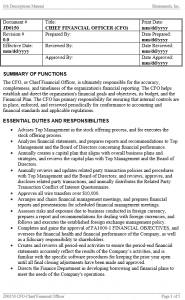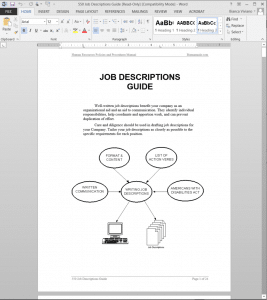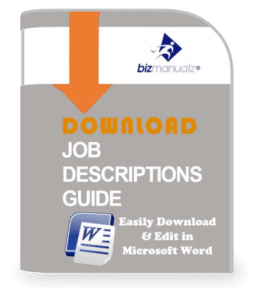How Do You Write Job Descriptions?

Writing Job Descriptions is easily learned. Job descriptions are prepared for all positions in the company to serve as an organizational aid for identifying and delegating responsibilities, coordination, and division of work and prevention of duplication of efforts. How do you write job description?
How to Write Job Descriptions
Supervisors should be responsible for initiating drafts or changes to existing Job Descriptions. Whenever practical, supervisors should interact with employees in developing or reviewing descriptions for accuracy and clarity.
Job Descriptions should:
- Be current and appropriately represent the position and the needs of the company at all times.
- Be updated whenever reassignments of duties or organizational changes are required.
- Mirror the growth and changes of the company. Supervisors should not fall into a routine of allowing individuals or their operations to be governed by pre-existing descriptions.
- Be filed behind the respective department’s organization chart in the Organization Structure section of the Company’s Policy & Procedures Manual.
Supervisors should then work in conjunction with the Personnel Coordinator to finalize the Job Descriptions. The Personnel Coordinator should be responsible for typing, printing and distributing completed descriptions.
Jobs are subject to change due to organizational development and/or the evolution of new technologies. Flexible job descriptions encourage employees to grow and make larger contributions to the company. A well-written, practical job description will avoid refusals to carry out relevant assignments because “it isn’t in my job description.”
For example: If your office manager is stuck;
“Routinely ordering office supplies for the company and keeping the storage closet well stocked,”
then rewrite the task description to involve more initiative and scope. Try:
“…developing and implementing a system of ordering office supplies that promotes cost savings and efficiency within the organization.”
Non-Discriminatory Language in Job Descriptions
Discrimination is unlawful, unproductive, and inappropriate within a business organization. It is important therefore that job descriptions reflect compliance with requirements and do not contain discriminatory terms or result in a discriminatory outcome, both of which tend to exclude potentially good candidates from job opportunities.
Non-discriminatory language is used to include rather than exclude people and is typically concise and more accurate than the other terms. It sends a clear message that your organization is unbiased and does not condone the use of stereotypes. Using non-discriminatory language in your job descriptions demonstrates equal employment opportunity (EEO).
For example, terms like “cleaning lady” and “foreman” tend to exclude on the basis of gender. By using terms such as “cleaner” and “supervisor” instead, the job description will be inclusive and nondiscriminatory. Also, be mindful of using pronouns that tend to exclude, such as “his, he, him” or “her, she.”
 Active Voice
Active Voice
Active voice rather that passive voice is recommended when writing job descriptions, particularly responsibility statements, because it is a more direct and concise style of writing.
Passive voice example:
As may be necessary, to coordinate with suppliers, the incumbent must answer telephone inquiries.
Active voice example:
Coordinate and negotiate with suppliers all equipment purchasing and delivery.
Note that the active voice example is more direct and less focused on how the task is achieved (i.e. by the telephone) and more focused on the outcome (i.e. purchase and delivery of equipment).
Action Verbs
Action verbs are used to directly and concisely describe actions and are more effective in the present tense when writing job descriptions.
Active verb example:
“Approve and verify (action verb and present tense) financial reports to comply with legislative and government financial reporting requirements.”
This is an example of how action verbs are used in the present tense to keep job responsibility statements short and to the point.
Plain English
Complex sentence construction and jargon is difficult for most people to understand and tends to exclude potentially good candidates for a job, thereby reducing the applicant pool. Plain English simply means writing in a way that is direct, clear and concise.
Be aware that in our work most of us routinely use jargon and acronyms that can be confusing to both internal and external people. For example, “EOE”, “DIR”, “MGR”, “EEO”, and “QA” may not be universally recognized abbreviations. Write in plain English by avoiding acronyms and/or explaining what they mean at least once. Avoid long or complex sentences and phrases that include redundant words. Use an active voice with action verbs to reduce confusion.
Brevity
There are no rigid rules about how long a job description must be. It is recommended however that job descriptions are concise. A good job description would provide sufficient detail about the job to provide an accurate and straightforward description of the job. This will enable applicants and job evaluators to understand the key elements of the job and work environment.
The job description doesn’t have to include significant detail about the organization because information about the organization is included in documents sent to applicants and is available on the Internet. Applicants can also obtain more detail about the job and the organization on request from the contact officer.
What is a Good Job Description Format & Content
Job Descriptions should be prepared using a Job Description Format similar to the samples at the end of this section. Any unusual needs or requirements for the position should be added in a separate section. The format outline should be completed as follows:
Job Title
The title should be short and simple yet as descriptive as possible. The applicable department should be listed.
Effective Date
This is the latest revision date to the description or the implementation date.
Department
Identify the Department-by-Department Code and/or Department Name.
Summary of Functions
This should be a one or two sentence statement encompassing the basic function and objectives of this position so the applicant or employee can grasp at a glance the key reasons why the job exists. It should enable anyone reasonably familiar with the organization to understand the primary purpose of the position. Any constraints, particular emphasis or shared responsibility can also be mentioned.
Below are some typical examples. Notice each begins with an action-verb followed by specific details of what is done and why it is done.
Example: financial position
“Contribute to the planning, development and implementation of financial policy that will ensure that income exceeds expenses.”
Example: managerial position
“Manage the human resources of the organization efficiently and effectively, to achieve employment performance outcomes.”
Example: supervisory position
“Supervise and manage the maintenance staff to achieve effective and efficient high quality maintenance services.”
ESSENTIAL DUTIES AND RESPONSIBILITIES
This section should briefly describe specific job tasks with details of the major duties and/or responsibilities for performing the job. Whenever possible use descriptive terms related to the objectives or action of a particular function rather than to indicate merely what is done. It is very important to note specific deliverables for a task.
For example, the statement:
“Supervises all personnel that process customer orders for shipment and billing.”
Could be better stated as follows:
“Supervises Telemarketers in taking phone orders from customers and processes all orders within 24 hours to ensure prompt shipment and billing. Manages daily activity reports to optimize resources for number of calls taken, average call length, average call volume per hour, number of orders taken, and average sales per call.”
It is recommended that job descriptions contain no more than ten duties, ideally five or six duties is best in order to make the responsibilities description easier to understand. Try to describe all the specific aspects of each job in a short space. Related tasks or activities should be grouped together to describe what is to be achieved. Usually, the higher level jobs use broader duty statements.
For example, the word “manage” incorporates a considerable range of separate tasks that comprise a full set of managerial responsibilities.
Analyzing the job helps in developing brief statements that describe the duties of the job. Start by listing all single activities or tasks. Then, list all the outcomes or results to be achieved in the job. And finally, group together related tasks to make up an entire process or service.
Group Several Tasks into a Single Responsibility
The separate tasks of writing letters, taking and making calls to customers, dealing with customer complaints and giving them advice, can be grouped into a statement like “Maintain good customer relations and provide a timely and accurate advisory service to customers.”
Points to consider when writing clear, brief job statements:
- List the duties in a way that highlights their general order of importance.
- Include important but infrequently performed duties.
- Use active voice in the present tense.
- Use action verbs which best describe the task or activity (see examples are in Appendix 1, List of Action Verbs.).
- Refer to critical timeframes to be achieved.
- Focus on the results, outcomes to be achieved, or deliverables required rather than the way a duty is to be performed.
The last point is important to consider because the way a job is described can result in unlawful discrimination. Stating exactly how the job is to be done may disadvantage specific groups of people such as those with disabilities. By recognizing that job outcomes can be achieved in different ways, emphasizing outcomes is more inclusive.
Writing Results-Oriented Job Statements
- The main action to be performed (action verbs are helpful).
- The result or outcome to be achieved (why it is done), and, if applicable:
- Include resources or equipment to be used and to whom the action relates.
Responsibility Statements
- Develop, deliver, and evaluate education and training programs to enhance staff knowledge and skills that will result in improved service delivery to Institute customers.
- Provide computer-based administrative support services for the Director and staff including: word processing, spreadsheets, database updating.
- Monitor the budget and report to the Director on the current financial status of the Faculty at the end of each month to ensure expenditure remains within the Faculty’s budget allocation.
Delegated Responsibilities
Many jobs include decision-making authority delegated under legislation or by the Board of Directors or Top Management and can be a significant part of the job. This information is important for job evaluators and applicants to gauge the level of responsibility of the job.
Where a job has a significant number of delegated responsibilities far too numerous to write in detail, the general statement such as the one below can be used. Detailed information can be given to applicants on request, particularly external applicants who do not have ready access to the delegations manuals.
Other indicators that can be used to show the level of responsibility or influence the job include:
- The total annual budget allocation.
- The annual budget for programs, salaries, administration, equipment, and resources.
- The number and employee groupings of staff reporting directly and indirectly.
- A sample of the key delegated responsibilities such as $100,000 for contract approval.
- Significant advisory roles (e.g. policy advice to state, national, and international forums).
Organizational Relationships
This section should outline the reporting relationships between this position and other key positions including supervisors and positions supervised. This statement should also include the requirements for coordination with other positions or departments.
Reporting Relationships
Reporting relationships say a lot about the organizational environment. A brief description of who reports to who, particularly in the form of an organizational chart, helps to clarify job expectations and level of responsibility. A simple organizational chart may be preferred by applicants because a visual representation is often more effective than words in conveying a message. In either case, the best rule is “Keep it simple!”
A useful guide for what to include is:
- The title and classification of the supervisor/manager to whom the jobholder reports to directly, and the next job-level above.
- Other jobs reporting to the same supervisor/manager.
- Any jobs and their classification level reporting to this job.
- Any significant indirect reporting relationships (e.g. reporting but not supervisory relationships).
The Organization’s Environment
Optionally, a statement about the organization’s environment can be added to provide useful information about the nature of key challenges the organization faces, particularly those directly affecting the work unit and the job. Keep this as brief as possible in order to reduce confusion.
For example:
“The primary role of the Department, Region or Division is…”
“Major strategies promoted by the organization, its key goals or values are…”
“Primary objectives of the work unit, its functions and where the job fits in are…”
“Important environmental factors such as legislative or policy; client base; nature of work and client demand; geographical location or changes impacting the job and service provision are….”
QUALIFICATIONS
If applicable, indicate the minimum requirements necessary to be able to fill the position. Use this section to list the Selection Criteria for applicants.
For example, this can include a description of the minimum years of experience or accomplishments in specific job categories or completion of degrees from colleges, technical or trade schools necessary to perform this job.
Selection criteria are the factors against which job applicants are assessed for their suitability to the job. It is therefore critical to develop selection criteria that will clearly and accurately describe the knowledge, skills, abilities, and qualifications required to perform the job successfully.
There are two types of selection criteria – mandatory requirements and key selection criteria that relate to the purpose, duties, and responsibilities of the job.
Mandatory requirements
A mandatory requirement for the job is included when it is considered necessary to selection criteria. Specifying mandatory requirements when they are not necessary to perform the job can reduce the applicant pool considerably and may potentially result in indirect discrimination.
Educational qualifications are the most common mandatory requirements specified in some job descriptions. Some others may be:
- An automobile driver’s license, commercial, or heavy vehicle license.
- A license or certificate by a registration board or professional body.
- Membership or eligibility for membership of a registration board or professional body.
- A boat or captain’s license.
Example – Professional
- Possession of a degree from a recognized educational institute, diploma or associate diploma in [indicate specialist field such as drafting], or agreed equivalent as determined by the Director of Human Resources.
- Providing eligibility for professional certification such as a Certified Public Accountant (CPA) or Professional Engineer (PE).
- Association or other qualification acceptable to the Director of Human Resources.
When writing mandatory requirements, it is recommended that you indicate the area of specialization (i.e. psychology, information technology) rather than the specific name of the qualification (e.g. Bachelor of Arts – Psychology). This will help to avoid unnecessary restriction on the applicants.
The Director of Human Resources should determine whether an applicant has demonstrated learning equivalent to that which would have been acquired through achievement of a relevant mandatory qualification such as a degree.
Key Job Description selection criteria
Key selection criteria are the key (but non-mandatory) competencies that job applicants will be assessed against for employment.
It is recommended that job descriptions contain no more than five or six key selection criteria. Job applicants and selection committees will benefit from this because the tasks of applying for a job and assessing candidates is more manageable if the number of selection criteria are limited.
The most important consideration is whether the selection criteria accurately and comprehensively describe the competencies of the job in an easy to understand way.
Developing Selection Criteria.
Some points are particularly relevant to promoting the Department’s key aim of equal employment opportunity:
- List the selection criteria in a way that emphasizes their order of importance.
- Use selection criteria that are measurable so applicants can be assessed on how well they meet the criteria (i.e. typists must be capable of accurately typing XX words per minute).
- Use active voice in the present tense.
- Avoid ambiguity and grouping unrelated competencies together.
- Apply the concept of transferable knowledge, skills, and abilities or the potential to acquire such competencies on the job or with further training.
- Specify the generic skills required for the job rather than specifying organizationally-specific knowledge and experience.
- Include a selection criterion requiring awareness of or commitment to your key organizational values (e.g., ethical standards of practice, equal employment opportunity, non-discrimination, workplace health and safety, quality customer service, etc).
NOTE: Testing for skills that are necessary to perform the essential functions of the job must be administered to all applicants for the same position, whether or not they have a disability. If testing is performed then make sure the test criteria are well documented in the job description.
Appropriate selection criteria can be developed by analyzing the particular competencies (i.e. knowledge, skills, abilities, and qualifications, if any) needed to achieve the outcomes of the job.
For example
- Skills, knowledge, abilities:
- Good written and verbal communication skills.
- Time management skills.
- Above average interpersonal communication skills.
- Problem-solving skills.
- Research and analytical skills.
PHYSICAL DEMANDS
The Physical Demands section can assist the company in identifying the most qualified applicant available for a specific job based on reasons unrelated to a disability. The documented demands of a job can be used as a basis for Americans with Disabilities Act (ADA) compliance or workers compensation claims.
Use this section to list the typical demands for applicants. Explain the primary demands that require physical and/or mental activities with enough detail in order to make a reasonable distinction for and workers compensation issues that may arise.
For example, consider each of the five senses (sight, sound, smell, vocal, and touch) and determine how they may be necessary to perform this job.
- Ability to communicate orally with others. (co-workers, supervisors, vendors).
- Regular use of the telephone and e-mail for company communication is essential.
- Sitting for extended periods is common.
- Standing at a workstation for extended periods.
- Hearing and vision within normal ranges is essential for safe conduct on the manufacturing floor.
- Ability to distinguish standard colors.
- No heavy lifting is expected. Exertion of up to 10 lbs. of force occasionally may be required (e.g., the approximate weight of 3 large telephone books).
- Good manual dexterity for the use of common office equipment such as computer terminals, calculator, copiers, and FAX machines.
Then consider the mental requirements that may be necessary to perform this job.
- Good reasoning ability is required to solve a wide range of business problems.
- Able to perform basic mathematics; addition, subtraction, multiplication, and division.
- Able to apply statistical calculations, analysis of variance, correlation techniques, and sampling theory as well as algebra, linear equations, and other analytics as required.
- Able to understand and utilize financial reports and legal documents to conduct business.
The documented demands of a job can become a very important element of a company’s defense for ADA compliance or workers compensation claims.
WORK ENVIRONMENT
Describe the workplace environment of the position. Explain any special circumstances involving the physical area that may be important. Is it load and noisy, quit, dirty, dangerous, hot or cold, indoors, outdoors, an office or a factory.
For example, in an office:
The job is performed indoors in a traditional office setting. Activities include extended periods of sitting and extensive work at a computer monitor and/or calculator.
Writing Job Descriptions
Job Descriptions are not absolute. Employees can be required to perform work outside of the job description. The Fair Labor Standards Act (FLSA) limits the types of work employees age 18 and older may be required to perform.
However, there are restrictions on what work employees under the age of 18 can do. This is true whether the work asked of the employee is listed in the employee’s job description or not. So write job descriptions for flexibility, plan for change, and keep them up-to-date.
















